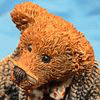
Red Shetland is a character created by Jim Groat & Richard Konkle. Used with permission as part of a Red Shetland calendar circa 1993. There have been many themed calendars. More Red Shetland art may be found via "rabbi-tom" here on FurAffinity: https://www.furaffinity.net/user/rabbi-tom/
Gunner Shetland is in a setting with tech (and situation) similar to the 1860s tech of the USA Civil War. The Gunner is the gun-captain and gun-aimer this time. The gun-crew and other defenders of this riverside fort are celebrating her aim and the resulting explosion of the enemy gunboat. I understand that if even an ordinary small cannonball can make it though an opening in the armor of even a metal-clad steam gunship (a lucky (?} shot through an open gun-port?), then the cannonball can bounce around inside. Disastrous damage can happen in an instant. In this case, the explosion of the ship's gunpowder magazine.
A fort like this was to shelter guns and guncrews from attack. The guns were usually inside the fort and much larger. The attackers would usually have large guns on riverboats (with and without heavy armor protection) and with attacking soldiers landing in small boats and sometimes moving along the riverbanks. The small mobile cannon would be used against masses of soldiers, where it could be quickly moved where it was needed.
Gunner Shetland is in a setting with tech (and situation) similar to the 1860s tech of the USA Civil War. The Gunner is the gun-captain and gun-aimer this time. The gun-crew and other defenders of this riverside fort are celebrating her aim and the resulting explosion of the enemy gunboat. I understand that if even an ordinary small cannonball can make it though an opening in the armor of even a metal-clad steam gunship (a lucky (?} shot through an open gun-port?), then the cannonball can bounce around inside. Disastrous damage can happen in an instant. In this case, the explosion of the ship's gunpowder magazine.
A fort like this was to shelter guns and guncrews from attack. The guns were usually inside the fort and much larger. The attackers would usually have large guns on riverboats (with and without heavy armor protection) and with attacking soldiers landing in small boats and sometimes moving along the riverbanks. The small mobile cannon would be used against masses of soldiers, where it could be quickly moved where it was needed.
Category Artwork (Traditional) / All
Species Unspecified / Any
Gender Multiple characters
Size 1280 x 963px
File Size 317.1 kB
Listed in Folders
Mobility. During one of the battles of the Boer War, the Boer artillery commander kept moving his guns around to keep them from getting targeted by superior British counter-battery fire. It was murder on the horses, but none of the Boer guns were put out of action.
Or, Red thought she could get a better shot at the gunboat.
Or, Red thought she could get a better shot at the gunboat.
On the far right, on & by the 2-wheeled 'limber' (towing cart), one crew member holds open the top of an ammunition chest. She (or the other crew member there) will take a cannonball and bag of gunpowder up to the front of the cannon, where the two loaders (at the wheels, moving the cannon back up) will take the powderbag and cannonball and ram them down the bore. The two 'ammunition runners' are similar to the guncrew shown here: https://www.furaffinity.net/view/37165790 (in action). The 7 crew members are the standard for this size of cannon, but they are all trained to be able to attempt any of the other duties. In desperate situations, one person has done all the jobs in sequence to fire the cannon.
They were, especially when you knew how hot and humid they would be inside. And how thin most of the armor really was. It might keep out rifle fire, but not much more. Sometimes they would put 2 medium-sized guns up front and put slanted armor in front of them. (Those were often the tinclads used for ramming!) Most of the sides & back on those were still thin metal, or even cotton bales.
The army brass were so happy, they wanted that photo of Red in dress uniform, to recruit young adventurous female volunteers. (And some male ones, too.)
The army brass were so happy, they wanted that photo of Red in dress uniform, to recruit young adventurous female volunteers. (And some male ones, too.)
Well done, subject and delineator!
I have some experience with cannons and fortresses. This tableau is located at a former place of employment, now a museum. The model for their Gun Captain was a friend and former coworker.
I have some experience with cannons and fortresses. This tableau is located at a former place of employment, now a museum. The model for their Gun Captain was a friend and former coworker.

 FA+
FA+
















Comments